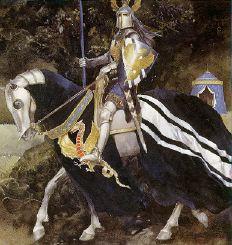I caught the Sunday Matinee yesterday and I thought it was pretty good. I’m not sure what the critics are complaining about. Just because there wasn’t an explosion per minute, the murder and mayhem were limited and Tautou and Hanks weren’t jumping each other’s bones every ten minutes doesn’t make it a bad movie.
As far as the underlying history, I had the same basic left eyebrow arched reaction that I had when I read the book. There is just enough history and plausibility mixed in with the rampant speculation to make you go “Huh?” Then you think about it for a minute or two and realize that it’s the speculation holding the whole thing together. Once you loosen that, it falls apart.
Here’s a review of the points made in the movie in support of the theory.
Constantine – Presented pretty accurately. After securing the throne in a civil war, the Emperor needed peace and quiet to solidify his position and religious strife was definitely one of the things he wanted to get under control especially the squabbling between the various Christian sects. The Council of Nicea was organized to establish the definition of Christian Orthodoxy. Constantine himself remained a pagan until being baptized on his deathbed. The Roman senate even deified him after his death.
The Council of Nicea – The primary focus of the council was the definition of Christian Orthodoxy and, in particular, the problem of Arianism, a position being taught by Arius, a priest in Alexandria. Arianism held that the Son was distinct from the Father, of different substance from the Father and created by the Father. Orthodox Christianity holds that the Son is consubstantial, of one and the same substance or being, and coeternal with the Father. Arianism was condemned at the council, some say after Constantine indicated that he favored the opposing view, and Arius excommunicated. Arianism had a revival a while later and Arius was reinstated. It's rumored that an Arian Bishop baptized Constantine just befre he died. Constantius, Constantine's son, was a supporter of Arianism and the position prospered while he was on the throne, but with his death, Arianism fractured and ultimately was decreed again to be heretical.
So, the claim that Constantine decreed the divinity of Jesus isn't quite true. He merely sided with the faction that held that the Son was as divine as the Father. One wonders however what Christianity would look like today if Constantine had supported Arius' view?
The Gospel of Philip – One of the Nag Hammadi documents and pretty much as quoted in the movie. Mary Magdalene is described as the “companion” of Jesus, someone Jesus loved more than all the other disciples and it’s said that he “used to kiss her often on her mouth.”
The Paintings of Da Vinci – Da Vinci was a strange duck and I wouldn’t put anything past him. He was probably the single most intelligent and talented human being ever to walk the planet. He was a true genetic fluke, comparable to Michelangelo in art, and Einstein in scientific intelligence. But as for a secret message in his painting "The Last Supper," two points. First, the reclining female like figure is almost universally considered to be John, the youngest of the apostles, who is often represented by a feminine looking long haired individual. Second, if Da Vinci was the keeper of such a secret, it would have been pretty stupid of him to risk that someone might figure it out from the clues in the painting and Da Vince was far from stupid.
The Priory of Scion – There was such an order in the Middle Ages, but it was short lived, a fairly typical Monk’s order and not at all related to the Holy Grail.
The Holy Grail – Traditionally the cup used by Jesus at the last supper and the objective of the Knights of King Arthur. Galahad, Percival and Bors are the Grail Knights who are ultimately allowed to view the grail after which Galahad, the perfect knight, requests death and the request is granted. The Avatar in the upper right hand corner of this web page is Galahad.
The bottom line is that despite what Dan Brown and the authors of “Holy Blood, Holy Grail” might say, there is no credible evidence for the underlying plot of the movie. Is it possible that Mary Magdalene and Jesus were husband and wife and had a child? Yes it’s possible. Is there any evidence to that effect? Nope, not one iota, but it’s a good movie, and an even better book. They're not high philosophy nor rocket science, but entertaining enough and I highly recommend both.
Subscribe to:
Post Comments (Atom)


1 comment:
Very pretty design! Keep up the good work. Thanks.
»
Post a Comment